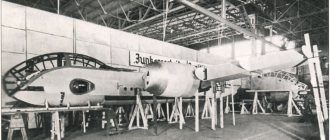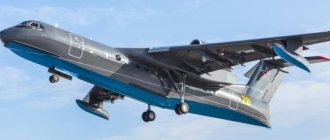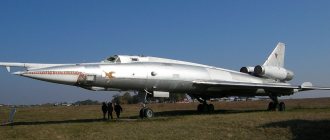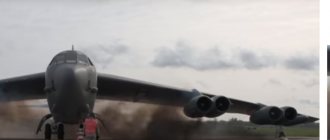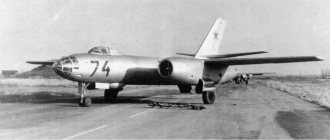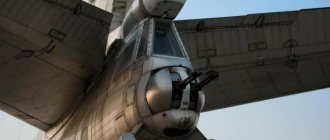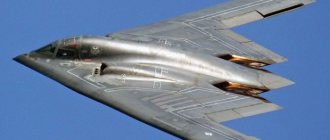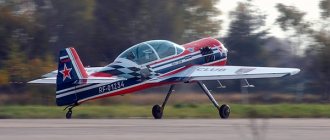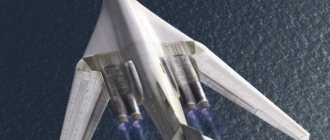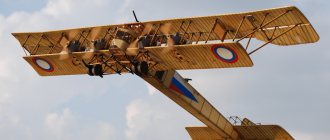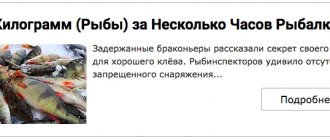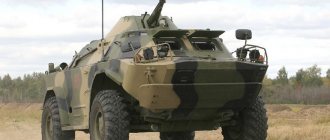Tu-2 (ANT-58, aircraft "103"), which according to NATO codification was called the "Bat", is a Soviet twin-engine daytime high-speed bomber of the Great Patriotic War.
History of Tu-2
The creation of a long-range daytime dive bomber capable of delivering precision strikes on enemy ships was first discussed in April 1939.
The aircraft was required to have speed and service ceiling values close to those of enemy fighters, and to perform high-speed dives with minimal attack time. It was planned to install four M-105TK turbocompressor engines and modern electrical equipment on the aircraft for flights over the sea in any weather conditions.
The project in the design bureau was called “product 57”, and officially - the PB aircraft. In parallel, the development of a twin-engine PB vehicle equipped with M-120 TK engines was carried out.
After the outbreak of World War II, the creation of twin-engine dive aircraft to attack British ships was questioned due to their poor effectiveness. But the developments in “product 57” were used to develop a “land” twin-engine dive bomber - “aircraft 103”. The official name of the new aircraft is FB (front-line bomber). This aircraft became the second most important Soviet aircraft, which was developed by A. Tupolev after his arrest.
The preliminary design was ready by February 1940, and already in March the decision was made to build a prototype.
The design included the installation of 2m-120K engines; the backup version included AM-35A engines. Construction of the aircraft began in May 1940, and in August the Tupolev bureau provided working drawings. During the manufacturing process, it was planned to re-equip the device with AM-37 liquid-cooled engines.
Development
| This article or section needs revision. Please improve the article in accordance with the rules for writing articles. |
In April 1939, a decision was made to create a long-range dive bomber to carry out targeted strikes on enemy ships on the high seas and at their bases.
The aircraft had to have a flight altitude no less than the practical ceilings of potential enemy fighters and a flight speed close to them; possibility of high-speed diving with minimal attack time; flight radius to at least the main British naval base of Scapa Flow in the Orkney Islands. It was planned to use 4 M-105TK engines with turbochargers on the plane and install the most advanced equipment for flying over the sea in any weather conditions, both day and night.
The project received the internal designation “product 57” and the official designation “ PB”
"(dive bomber). In parallel with “product 57”, a twin-engine version of the “PB” with M-120TK engines (English)Russian was being developed.
With the beginning of World War II, doubts arose about the feasibility of creating a naval dive bomber for attacks on British shipsK: Wikipedia: Articles without sources (type: not specified)[ source not specified 3417 days
], and work begins on a front-line dive bomber with two engines.
All developments on the “product 57” remained in force, and the twin-engine “land” version received the internal designation “product 58”, or “aircraft 103” (after the name of the Tupolev department in the NKVD OTB - the aircraft was designed in the prison conditions of TsKB-29, the famous also known as "sharashka"). There was also an official name for the vehicle - “ FB
” (front-line bomber). The Tu-2 was the second most important Soviet twin-engine bomber designed by Andrei Tupolev after the arrest.
By February 1940, the preliminary design of the aircraft had been worked out, and in March a decision was made about experimental construction. The code assigned to the vehicle is aircraft “103” 2M-120TK. The backup option provides for the installation of AM-35A engines on the aircraft. Construction of the aircraft began in May 1940, and in August the design bureau handed over working drawings. During the production of the aircraft, the aircraft had to be reconfigured to accommodate AM-37 liquid-cooled engines.
The aircraft was an all-metal twin-engine high-wing aircraft with a two-fin tail, a wing of a caisson structure with flaps and brake grilles. Thoughtful rational placement of a crew of three, armor protection, good defensive weapons, a fire-fighting system with filling of fuel tanks with inert gas distinguished the aircraft better from other aircraft of that period.
On January 29, 1941, test pilot M. A. Nyukhtikov performed the first flight. State tests took place in June-July 1941, in parallel with the second machine “103U” (product 59). Based on the test results, a decision was made on further work on the “103” aircraft, but without launching it into series. On the basis of “103U” with an increased crew of up to 4 people (a gunner was added to defend the upper hemisphere), it was decided to begin mass production. In September 1941, at the Omsk aircraft plant No. 166 (evacuated Voronezh plant No. 18 and Tushino No. 81), the assembly of 103U aircraft began, in a series renamed 103C, with M-82 air-cooled engines.
The “103V” aircraft (product 60) was designed in parallel with the “103” and “103U” aircraft for the new M-120TK-2 engines. The lack of new engines on time forced the project to be reworked for M-82A engines. Due to the unfinished power plants, the tests dragged on until August 1942. During testing, the aircraft officially became known as the Tu-2. The first production 103BC vehicles began to enter service with the troops in March 1942. Based on the experience of combat use, the aircraft was modified - defensive weapons were strengthened and power plants were modified to increase the reliability of their operation. In total, Plant No. 166 built 80 Tu-2 2M-82 aircraft.
On July 17, 1943, GKO Decree No. 3754 was issued to restore serial production of the Tu-2 with 2M-82FN, which received the name Tu-2S (“S” - “Serial”), or “product 61”.
The aircraft received new star-shaped engines ASh-82FN, which had better thrust than the previous AM-38, but due to increased mass and drag, the maximum achievable speed in horizontal flight was reduced. By increasing the thrust parameters of the engines, the armament was also redesigned, the aircraft was able to carry on board up to 3 bombs with a total weight of 3 tons, and the defensive armament was also strengthened, which now included UBS machine guns (12.7 mm) instead of the previous ShKAS caliber 7 .62 mm. A huge amount of work was done to lighten the aircraft, simplify it, and unify production. In particular, on the aircraft, in order to increase combat survivability and reduce the labor intensity of maintenance, the hydraulic system and electrical equipment were simplified as much as possible, including the removal of all internal lighting lamps, and the scarce shielded wiring was partially replaced with conventional wiring, if there was natural shielding in the design of the airframe elements. The Tu-2 of the first production had a serious drawback - a tendency to turn around at the end of the run, caused by the peculiarity of the system of separate braking of the wheels by the track control pedals and the poor performance of the hydraulic lock of the neutral position of the tail wheel. The system was completely redesigned according to the ideology of the Li-2 aircraft.
On the basis of the Tu-2S, the Tu-2R reconnaissance aircraft was produced; nothing, except for the presence of cameras in the fuselage, did not differ from production vehicles, which could also carry a full combat load.
Production was initially organized at plant No. 22 in Kazan, then the main production was left at the plant, and the aircraft was serially built at plant 23 in Moscow and plant 166 in Omsk. During the war, 800 aircraft were produced, of which about 750 aircraft reached the front.
Serial production of the Tu-2 continued from 1942 to 1952 (1 prototype in 1941). In total, until 1951, domestic factories supplied 2,649 Tu-2s of various modifications, not counting experimental ones, and converted 176 bombers into UTB[1].
Bomber Tu-12
Bomber Tu-12
At the Tupolev Design Bureau, the turbojet engine (instead of the ASh-82FN) began to be tried on the Tu-2. Naturally, nothing good came of this, and all the work to “modernize” the aircraft of the last war ended with the creation of several flying laboratories on its basis.
In accordance with the government decree of April 9, 1946, OKB-156 was ordered to develop a twin-engine jet bomber.
The problem of creating such a machine could be solved only if there were engines with a thrust of at least 2000 kgf. Such an opportunity presented itself at the beginning of 1947 after the acquisition of the Derwent V and Nin turbojet engines in England. Based on the latter, the USSR began to produce the engine, first the RD-45, and then its variant RD-45F with a thrust of 2270 kgf.
The development of the first versions of the bomber based on the “69” aircraft, which received the serial number 72 at OKB-156, and the “73” aircraft, which was close in size and had another designation Tu-20, showed that they would not fully satisfy the requirements customer, and moved on to creating the next machine “73” with pressurized cabins.
After the completion of the work of the mock-up commission on the 73 aircraft in February 1947, the military put forward additional requirements, to satisfy which the thrust of two Ninovs was not enough, and then they went to the extreme - they proposed placing a third Derwent V engine in the rear fuselage with a thrust of about 1500 kgf.
They did not dare to build a three-engine aircraft, since it was contrary to government regulations, and then Tupolev took the initiative to develop two jet aircraft. His idea was picked up by ministers N. Bulganin, M. Khrunichev and Air Force Commander-in-Chief K. Vershinin and on May 15, 1947 sent a letter to I. Stalin, which, in particular, stated: “Tupolev, after studying the issue of creating types of jet bombers, made a proposal to build two types such planes...
The first aircraft is completely new with three jet engines (two Nin and one Derwent). It is made on the basis of special high-speed arms currently being developed [13]
and will have the following <…> data:
Maximum speed - 850–900 km/h.
Flight range - 3000 km.
Crew - 4 people.
Small arms - forward 2x20mm, rear 2x20mm.
Normal bomb load is 1000 kg.
Maximum caliber - 3000 kg.
The second aircraft - with two Nin jet engines, at the suggestion of Tupolev, is being built on the basis of the Tu-2 aircraft with the following <...> data:
Maximum speed is 775–800 km/h.
Flight range - 1250 km.
Crew - 4 people.
Small arms - forward 1x20mm, rear 2x12.7mm.
Normal bomb load is 1000 kg.
We consider it advisable to accept Tupolev’s proposal for the following reasons:
The first aircraft with three engines, in terms of its flight characteristics and armament, is a promising aircraft that will support our aviation for a fairly significant period of time.
The second aircraft is a kind of transitional type from an aircraft with piston engines to a jet <…>, since this <…> is made on the basis of the serial Tu-2, then simultaneously with the construction of the prototype it will be possible to lay down a series of these at plant No. 23 cars, without stopping the production of serial <…> Tu-2. This means that already in 1948 we will be able to obtain quite satisfactory jet bombers. The aircraft is well proven in operation and has simple flying techniques, which will continue on the proposed jet, since the wing remains the same.
In this regard, the mastery of these aircraft in Air Force units will be carried out with less difficulty and will help master the piloting of new jet bombers.
To ensure the production of a small series of jet bombers at plant No. 23, we ask for permission to reduce the annual program for serial Tu-2 aircraft by 50 units.”
Following this, a draft resolution of the Council of Ministers was prepared, which stated: “In development of the resolution of the Council of Ministers of the USSR of April 9, 1946 No. 796–318 on stimulating development work on the creation of jet engines, jet aircraft <...> The Council of Ministers decides:
1. Accept <…> Tupolev’s proposal to create two types of jet bombers and oblige the MAP Comrade Khrunichev and the chief designer Comrade Tupolev to produce these aircraft within the following time frame:
A. A three-engine jet bomber (instead of the planned two-engine jet).
The aircraft will be built at plant No. 156 with the release date for flight testing of the 1st copy in November 1947.
B. Jet bomber with two Nin engines based on the Tu-2 production aircraft.
A prototype should be built at plant No. 156 in one copy and released for flight testing in September 1947...”
Tu-12 is the first jet bomber of the A. N. Tupolev Design Bureau.
This is how the history of jet aircraft construction began at OKB-156. But few people know that at about the same time, two semi-jet aircraft were being designed on the Yauza embankment - the reconnaissance aircraft "74" (Tu-22) and the bomber "76". Work on the first of them began in 1946 on the basis of MAP order No. 413 in pursuance of the government decree of June 20.
According to the assignment, the aircraft was to have a flight range of 3,000 km, reach a speed of 600 km/h at an altitude of 12,000 meters and rise to an altitude of 13,000 meters. A long flight in the stratosphere forced the provision of pressurized cabins for the crew. Calculations showed that the specified characteristics can not only be achieved by relying on two 14-cylinder M-93 engines with a power of 2000 hp each, but also surpass them. Thus, at an altitude of 12,200 meters, the speed reached 620 km/h, the practical ceiling was 13,200 meters, the ascent time to 10,000 meters was 21.4 minutes, and the range was 3,750 km. Not bad data, but the hopes placed on the M-93 were not justified.
Since no one removed the task from the OKB, a solution was found by replacing the M-93 with the tested ASh-82FN and additionally placing the Nin turbojet engine in the rear fuselage. According to the plans of its ideologists, piston engines, which were highly efficient, guaranteed flight over a given range, and jet engines (if necessary) ensured a rapid increase in speed. This is how a new aircraft design was born, which was subsequently further developed. True, in relation to the “74” aircraft, it cannot be called successful, since this hybrid would become very difficult to operate. Different power plants, which also required different fuel systems: gasoline and kerosene.
Work in this direction continued in 1948, when they relied on what seemed to be promising ASh-84TK engines, but they also failed. Project “76” suffered the same fate. As a result, the topics “74” and “76” were covered up, and the reconnaissance aircraft, so needed by the Air Force, was created in another design bureau. As for the three-engine scheme, it migrated to the “73” project.
The development of the future first-born OKB-156 jet (aircraft “77”) on the basis of the Tu-2 began long before the arrival of English engines in the USSR in accordance with the documentation received for them. To make a mock-up of the aircraft, they took an old Tu-2, although the mock-up was limited to placing a turbojet engine on the wing.
The predecessor of the Tu-14 was the three-engine bomber "73".
The Tu-14 never became a real front-line bomber.
The first Ninas arrived in the USSR in April 1947, and on July 27, test pilot A.D. Perelet took the Tu-12 aircraft into the air for the first time. Its significant difference from its piston counterpart was not only the jet engines and the new fuel system, but also the chassis with a nose wheel.
Tests of the vehicle showed that its normal flight weight, with the same payload capacity as the Tu-2, increased, mainly due to fuel, to 14,700 kg, and the speed did not exceed 783 km/h. The range remained almost the same as its predecessor - 2200 km. The flight data for the 1947 bomber was clearly insufficient, but it was nevertheless tested at the Air Force Research Institute from October 4 to February 27.
In the early 1950s, the IL-28 suited both the Air Force and Navy aviation in all respects.
The leaders at this stage were engineer V.A. Shubralov, pilot M.A. Nyukhtikov and navigator N.P. Tsvetkov. In particular, V.I. Zhdanov and P.M. Stefanovsky flew around the car. Military testers noted that the aircraft's piloting technique was accessible to moderately qualified pilots, but its takeoff and landing characteristics had significantly deteriorated. Shaking of the tail unit was noted due to its getting into the jet engines of the engines in some modes.
The absence, in particular, of pressurized cabins, anti-icing devices on the wing, empennage and windshields of the pilot's cabin and centralized fuel refueling significantly reduced its operational characteristics. There were other comments on the armament, crew armor protection, landing gear wheels and equipment.
Nevertheless, according to the flight data, the aircraft complied with the government decree, and specialists from the Air Force Research Institute expressed a desire to complete the construction of a series of aircraft at Plant No. 23 for use as flying laboratories.
As follows from the published materials on the Tu-12 aircraft, they were built in several copies. But they are absent from the MAP’s statistical materials for plant No. 23. And a jet bomber is not a needle in a haystack.
The second three-engine bomber, which received serial number 73 at the OKB, was transferred to factory flight tests in October 1947. The first flight of the machine, piloted by the crew of pilot F. F. Opadchy, took place on December 20 of the same year. But the “73” aircraft, like its subsequent modifications, including those with two VK-1 turbojet engines, turned out to be unsuccessful. The Il-28 turned out to be much more successful, becoming the most popular jet bomber of the first generation, but that’s another story.
Combat use
| This section is not completed. You will help the project by correcting and expanding it. |
The first three “103BC” vehicles (which initially did not have the name Tu-2) arrived for front-line testing. A factory team led by D.S. Markov arrived along with the planes. Both testers and front-line crews were involved in combat missions. A total of 25 flights were carried out, based on the results of which a conclusion was drawn up about the high reliability and efficiency of the aircraft. Front-line pilots, comparing the aircraft being tested with the Pe-2s in service, noted that the Tu-2 was much easier to fly, had the ability to continue flight on one engine, had a much more powerful bomb armament, and a number of other positive qualities. However, the low reliability of M-82 engines was also noted.
The first to be formed was the 132nd separate bomber air regiment on Tu-2 aircraft, which took part in hostilities from November 1942 to May 1943, after which the regiment was withdrawn to the rear for reorganization. The remaining serviceable vehicles were transferred to reconnaissance regiments. In total, 61 (according to other sources - 63) aircraft built by that time were subjected to military tests; 19 aircraft were lost in battles, and only 1 from enemy fire.
Mass construction and delivery of the aircraft to the troops began in the spring of 1944. The 334th BAP, consisting of three regiments - the 12th BAP, the 132nd BAP and the 454th BAP, was fully armed with the Tu-2S. By the beginning of 1945, there were 279 Tu-2 aircraft at the front, consolidated into the 6th Aviation Corps, and the 113th separate bomber division of the Supreme High Command reserve. After the end of the Second World War, the 6th BAC and 113 OBAD, which became part of the 7th BAC, were transferred to the Far East, where they participated in the war with Japan with great success.
The Tu-2 remained in service with the USSR Air Force in the post-war years, replacing the Il-4 and Pe-2, which were written off immediately after the war, and was used until the early 50s, until its re-equipment with jet aircraft.
Tu-2 was delivered to Bulgaria, Romania, Hungary, Poland, and China. In China, this machine was used until 1982. Some Chinese Tu-2s were shot down by British and American aircraft during the Korean War. It was also used by the PRC in battles with the troops of Chiang Kai-Shek. The Chinese also transferred a number of aircraft to Indonesia.
First stage: military trials in 1942/43.
The first three production Tu-2s, produced by plant No. 166, reached the Kalinin Front in September 1942. The vehicles ended up as part of the 3rd Air Army, commanded by Colonel General M.M. Gromov. Along with the planes, a group of specialists led by D.S. arrived at the front. Markov, who was responsible for the implementation and operation of the Tu-2. The bombers began their combat career at the Migalovo airfield near Kalinin on September 14, 1942.
Both test pilots and front-line pilots took part in the flights. During military tests, the vehicles made 25 sorties, an average of one sortie per day. During the Tu-2 sorties, they were exposed to threats from both anti-aircraft artillery and enemy fighter aircraft. However, the three bombers always flew with reliable cover, so the threat from fighters was less.
One of the most successful operations was the destruction of a fuel and lubricants warehouse and military equipment in the area of the village of Trostino. The first raids on the warehouse were carried out by Pe-2 bombers, dropping F AB-100 bombs on the target. However, these bombs turned out to be too weak. Then Tu-2s carrying FAB-1000 bombs were sent to the target. The bombers on this flight covered ten LaGG-3s. Their pilots were ordered to cover the bombers at any cost. During the raid, the detachment was intercepted by nine Bf 109s. The LaGGs managed to engage most of the Messers in battle, but several German fighters broke through to the Tu-2. However, thanks to the skillful actions of the gunners and fighter pilots, the attack was repelled without losses from the Tu-2. The bombers targeted and destroyed the warehouse, and then returned safely to base.
Front-line pilots rated the Tu-2 very highly. They emphasized the high efficiency of the aircraft, capable of dropping large bombs on a target, powerful defensive weapons, ease of piloting and high flight performance.
The Tu-2 was much easier to pilot than the Pe-2. The plane could easily fly on only one engine. The impression of the aircraft was spoiled only by the low reliability of the M-82 engines.
While testing of the Tu-2 trio continued at the front, training of pilots for the new bomber began in Omsk at plant No. 166.
The first Tu-2 aircraft were received by the 132nd OBAP (separate bomber air regiment) and the 12th BAP. In the spring of 1942, a special training unit was formed in which crews for the Tu-2 were trained.
The 132nd OBAP was sent to Omsk for reorganization and retraining in April 1942. Until this time, the regiment flew SB, Ar-2 and Pe-2. Since the regiment became the first unit to be equipped with new bombers, several employees of the Tupolev Design Bureau and NIIVVS were sent there. Among them were test pilots A.D. Perelet and V.N. Tereshchenko, factory pilot Yu.G. Paul. They became instructors, training the regiment's personnel and at the same time testing new vehicles.
The training of the 132nd OBAP was completed in September 1942. The regiment received 29 Tu-2s and, led by Lieutenant Colonel A. Khlebnikov, went to the Kalinin Front. The regiment took part in combat operations from November 5, 1942 to January 1, 1943. The pilots attacked targets in the front zone and behind enemy lines in the area of Smolensk, Vitebsk, Velikiye Luki, etc. Then the regiment was transferred to the Southwestern Front, where it operated until April 13, 1943. The activities of the 132nd OBAP represented a continuation of military tests of the Tu-2 and had a great influence on the future fate of the bomber.
In April 1943, the regiment's experience was summarized in a report that gave a comprehensive assessment of the new bomber. In total, the regiment carried out 93 sorties, including 46 on the Kalininsky and 47 on the Southwestern Front. 75 sorties were carried out for bombing and 8 for reconnaissance. In 23 flights, the combat mission was not completed, including eight times due to technical problems of varying complexity, including engine failure in flight. During the fighting, 9 Tu-2s were lost or damaged. Two vehicles did not return from the combat mission, the rest were lost as a result of accidents or made an emergency landing on their territory. By the end of its combat tour, the 132nd OBAP had 14 Tu-2s, of which eight required one or two engines. In total, during the time spent at the front, the regiment dropped 386 bombs on targets with a total mass of 6755 kg, including 25 FAB-1000, nine FAB-500, 28 FAB-250 and 297 FAB-100.
All bombing was carried out from horizontal flight. The bombing of the German garrison in Velikiye Luki at the end of December 1942 was especially successful, as well as raids on the railway junctions of Sinelnikovo, Pavlograd, Zaporozhye, Dnepropetrovsk and airfields in Smolensk and Zaporozhye.
A message from the Sovinformburo dated February 27, 1943 said: “... 18 German bombers were destroyed and burned.” This raid was carried out from a height of 400 m with FAB-100 bombs.
Despite the fact that the regiment flew during the day and without cover, German fighters failed to shoot down a single Tu-2. In general, unreliable M-82 engines posed a more serious threat. Their accidents caused 11 forced landings and the termination of ten combat missions. For various reasons, 17 engines had to be replaced, and eight more were in the last hours of their service life.
All aircraft produced by Plant No. 166 were used to equip units of the 3rd Air Army operating on the Kalinin Front. The pilots noted the superiority of the Tu-2 over the Pe-2 and Pe-3 aircraft. At low and medium altitudes, the Tu-2 exceeded existing bombers in speed by 100 km/h or more, and carried more bombs (up to 3000 kg). An important advantage was that the Tu-2 could fly freely with one engine running.
However, the Tu-2 was never used as a dive bomber. Later, aerodynamic brakes were removed from the aircraft and the idea of using it as a dive bomber was completely abandoned. During the war, the Pe-2 was the dive bomber, and the Tu-2 became a pure medium bomber.
Air Force Commander General A.A. Novikov wrote a letter to Stalin emphasizing the need to begin mass production of Tu-2 bombers. However, the general's request came too late. By that time, an order had already appeared instructing Plant No. 166 to proceed to the production of fighter aircraft. They returned to production of the Tu-2 a year later, when the Red Army launched a strategic offensive on all fronts, and the need arose for bombers capable of delivering a large mass of bombs over long distances.
Meanwhile, the following regiments were formed in Omsk and sent to the front.
The 2nd DRAP (Long-Range Reconnaissance Aviation Regiment) received four Tu-2s, including three in the reconnaissance version. The regiment flew Pe-3s, which acted as high-speed reconnaissance aircraft. For its services in carrying out especially important tasks of the Supreme Command, the regiment received the rank of guards and became known as the 47th GDRAP.
During the battles, which went down in history as the liquidation of the Demyansk cauldron, pilots of the 47th GDRAP daily photographed enemy fortifications. The Germans brought in a group of Fw 190s to intercept Soviet reconnaissance forces, and the regiment suffered heavy losses. In this situation, a Tu-2 piloted by V.F. took off for photo reconnaissance of the front line of defense in the area of Staraya Russa. Stolyarov. On the way back, the plane was intercepted by six Fw 190s and shot down. Of the entire crew, only the navigator managed to survive. The three remaining Tu-2s in the regiment made reconnaissance missions to the area of the airfield in Adrianople. By May 1943, the trio of Tu-2s had flown more sorties than all 29 Tu-2s of the 132nd OBAP combined.
In May 1943, the 132nd OBAP was moved to the rear. Ten Tu-2s from the regiment were transferred to the 47th GDRAP. Eight other Tu-2s were sent to the factory for repairs, and the remaining seven were distributed to front-line airfields.
The reconnaissance Tu-2 caused many problems to the German command, which sought to destroy dangerous vehicles at any cost. In turn, the Soviet pilots had a clear order to destroy the plane if it landed on enemy territory.
In addition to reconnaissance missions, Tu-2 crews from the 47th GDRAP flew to bomb areas where enemy railway rolling stock was concentrated in Vitebsk, Borisov and Minsk. Good defensive weapons allowed the Tu-2 to repel attacks by German fighters. In May 1943, the crew of V.N. Tereshchenko repelled an attack by four Bf 109 fighters during a raid on Minsk.
The 47th GDRAP flew the Tu-2 throughout 1943, and then received the Tu-2S.
In December 1942, the 12th BAP, equipped with a Tu-2, took off from Omsk, which then also operated on the Kalinin Front until the end of 1943, when the battered regiment was taken to the rear for replenishment.
18 Tu-2s were part of the 285th BAD, which played a significant role in the Battle of Kursk.
In 1942/43 Tu-2 aircraft accounted for only a fraction of a percent of the total number of Soviet bombers. Only 63 of those produced by Plant No. 166 operated at the front. These bombers remained in units until the beginning of 1944, when new Tu-2S began to arrive.
Comparison with analogues
Based on the totality of flight performance characteristics, manufacturability, and the ratio of combat losses per aircraft-sortie, the Tu-2 can be considered the best front-line bomber of the USSR in the Second World War, despite its rather weak contribution to the victory over Germany. Unfortunately, wartime difficulties did not allow mass production of this aircraft to begin in a timely manner.
The only serious drawback of the machine was the poor visibility from the navigator's workplace, the worst of all domestic and Lend-Lease wartime aircraft.
For the creation of the Tu-2, A. N. Tupolev received the rank of major general.
Modifications
- ANT-58
, “
Airplane 103
” - two Mikulin AM-37 engines of 1400 hp each.
each (water cooling). 1941 Speed - 635 km/h at an altitude of 8000 m[2]. Of the aircraft ready for mass production at the beginning of 1941, only the Tu-2 developed such a speed at such a high altitude. K: Wikipedia: Articles without sources (type: not specified) [ source not specified 4071 days
]. Ceiling - 10600 m, range - 2500 km[2]. - ANT-67
is a five-seat long-range bomber. - Tu-1
is a three-seat long-range fighter. - Tu-2
- two M-82 engines (air-cooled) 1450 hp each. with increased mass of armor protection. 1942 - Tu-2S
(
ANT-61
) is an aircraft with two Shvetsov M-82FN engines with star-shaped cylinders, 1670/1850 hp. , with a simplified composition of equipment, multiple modifications to reduce weight, increase survivability, and simplify operation. Basic model for mass production in 1943. - Tu-2D
(
ANT-62
) - long-range modification, equipped with two M-82FN engines pl 1670/1850 hp. 1943 - Tu-2DB
(
ANT-64
) - modification - long-range bomber. - Tu-2F
(ANT-64) - modification for reconnaissance by aerial photography, built at plant No. 39. - Tu-2G
is a high-speed cargo modification. - Tu-2K
- only two aircraft were built to test ejection seats. - Tu-2M
- experimental aircraft Tu-2 2M-82FN No. 716, converted to ASh-83FN engines, was not mass-produced. - Tu-2N
- modification for testing Rolls-
Royce Nene
. - Tu-2 “Paravan”
- two aircraft were built to test the paravan - a device that cuts cables from air balloons.[3][4] - Tu-2R
- reconnaissance modification. It was distinguished by the presence on board of an aerial camera and resp. equipment. Could be used as a bomber. - Tu-2Sh
- experienced attack aircraft, for testing various weapons - 88 PPSh-41 (!), two NS-37 and two NS-45, 57 mm RShR cannon (see Tu-2RShR) - Tu-2RShR
is a prototype, equipped with a 57 mm RShR cannon in the front part of the fuselage. - Tu-2/104
is a prototype of an all-weather interceptor. - Tu-2T
(
ANT-62T
) is a torpedo bomber based on the Tu-2S. - Tu-6
is a reconnaissance aircraft, built serially at plant No. 23. - Tu-8
(
ANT-69
) is a long-range bomber. - Tu-10
(
ANT-68
) is a prototype general purpose bomber. - UTB
is a training aircraft with Shvetsov ASh-21 engines (690 hp) created by Sukhoi OKB-51 in 1946, built serially. - Tu-2LL
- flying laboratory aircraft. In 1946-49. three serial Tu-2S were converted for testing and development of the first domestic turbojet engines. There was a modification for testing OKB-52 projectile aircraft and a modification for testing supersonic models.[5]
Flight performance
Data source: [10]
Specifications
- Crew: 4 people
- Length: 13.80 m
- Wingspan: 18.86 m
- Height: 4.13 m
- Wing area: 48.52 m²
- Empty weight: 7601 kg
- Normal take-off weight: 10538 kg
- Maximum take-off weight: 11768 kg
- Fuel mass in internal tanks: 2200 l
- Powerplant: 2 × PD ASh-82
- Engine power: 2 × 1850 l. With.
Flight characteristics
- Maximum speed: ground: 444 km/h
- at altitude: 521 km/h
Armament
- Small arms and cannon: two 20-mm ShVAK cannons, three 7.62-mm ShKAS machine guns and one 12.7-mm UBT machine gun
- Unguided rockets: 10 rocket guns for RS-132 projectiles
- Bombs: normal - 1000 kg, maximum - 2000 kg, overload - 3000 kg
Literature
- Vladimir Rigmant
Under the signs “ANT” and “Tu” (Russian) // Aviation and Cosmonautics. - M., 1998. - No. 3. - P. 42-48. - Yakubovich N.
In the air and on the ground. About the Tu-2 aircraft and its modifications (Russian) // Wings of the Motherland. - M., 2000. - No. 5. - P. 1-7. — ISSN [www.sigla.ru/table.jsp?f=8&t=3&v0=0130-2701&f=1003&t=1&v1=&f=4&t=2&v2=&f=21&t=3&v3=&f=1016&t=3&v4=&f=1016&t=3&v5 =&bf=4&b=&d=0&ys=&ye=&lng=&ft=&mt=&dt=&vol=&pt=&iss=&ps=&pe=&tr=&tro=&cc=UNION&i=1&v=tagged&s=0&ss=0&st=0&i18n=ru&rlf=&psz =20&bs=20&ce=hJfuypee8JzzufeGmImYYIpZKRJeeOeeWGJIZRrRRrdmtdeee88NJJJJpeeefTJ3peKJJ3UWWPtzzzzzzzzzzzzzzzzbzzvzzpy5zzjzzzzzzzzzzzzzzzzzzzzzzzzz zzzzztzzzzzzzbzzzzzzzzzzzzzzzzzzzzzzzzzzzzzzzzzyeyTjkDnyHzTuueKZePz9decyzzLzzzL*.c8.NzrGJJvufeeeeeJheeyzjeeeeJh*peeeeKJJJJJJJJJmjHvOJJJJJJJJfe eeieeeeSJJJJSJJJ3TeIJJJJ3..E.UEAcyhxD.eeeeeeuzzzLJJJJ5.e8JJJheeeeeeeeeeeeyeyeK3JJJJJJJJ*s7defeeeeeeeeeeeeeeeeeeeeeeeeSJJJJJJJZIJJzzz1..6LJJJJJJtJJZ4….EK*&deb ug=false 0130-2701].
Notes
- Yakubovich N.V.
Tu-2. The best bomber of the Great Patriotic War. - M.: Collection, Yauza, Eksmo, 2010. - P. 72. - 95 p. — (War and us. Aviation collection). - ↑ 12
Military DI-8 • DIP • I-1 • I-2 • I-3 • I-4 • I-5 • I-8 • I-12 • I-14 • Mi-3 • R-3 • R-6 • R-7 • SDB • TB-1 • TB-3 • TB-4 • TB-6 • TSh-B • • Tu-1 • Tu-2 • Tu-4 • Tu-6 • Tu-8 • Tu-10 • Tu-12 • Tu-14 • Tu-16 • Tu-22 • Tu-22M • Tu-22MR • Tu-24 • Tu-28 • Tu-64 • Tu-70 • Tu-73 • Tu-75 • Tu -78 • Tu-80 • Tu-81 • Tu-82 • Tu-85 • Tu-88 • Tu-89 • Tu-91 • Tu-95 • Tu-98 • Tu-107 • Tu-119 • Tu-121 • Tu-126 • Tu-128 • Tu-134UBL • Tu-142 • Tu-160 • Tu-214ON • Tu-214R Passenger Tu-70 • Tu-104 • Tu-110 • Tu-114 • Tu-116 • Tu-124 • Tu-134 • Tu-144 • Tu-154 • Tu-155 • Tu-204 (Tu-214/ Tu- 204-300) • Tu-214SR • Tu-214PU • Tu-214SUS • Tu-334 Amphibians MDR-2 • MDR-4 • MK-1 • MR-6 • MRT-1 • MTB-1 • MTB-2 • MER • Amphibious snowmobile A-3 Unmanned Tu-121 “S” • Tu-123 (“Yastreb-1”, DBR-1) • Tu-139 (“Yastreb-2”, DBR-2) • Tu-141 “Strizh” • Tu-143 “Flight” • Tu-243 “Flight-D” • Tu-300 “Korshun-U” Projects PAK DA • Tu-130 • Tu-131 • Tu-135 • Tu-136 • Tu-206 • Tu-230 • Tu-244 • Tu-324 • Tu-330 • Tu-344 • Tu-404 • Tu-414 • Tu-444 • Tu-2000 Bombers U-2VS • Su-2 • Yak-2 • Yak-4 • • Ar-2 • Pe-2 • Tu-2 • DB-3 • Il-4 (DB-3f) • DB-A • Er-2 ( DB-240) • TB-3 • Pe-8 Stormtroopers IL-2 • IL-10 Educational and training U-2 (Po-2) • U-5 • UT-1 • UT-2 • UT-3 • UTI-2 • UTI-4 • UTI-26 (Yak-7UTI) Spy plane R-5 • R-Z • R-6 • R-10 • A-7 Seaplanes Sh-2 • MBR-2 • MTB-2 • GST • KOR-1 (Be-2) • KOR-2 (Be-4) • Che-2 Transport and gliders Li-2 • Shche-2 • Yak-6 • PS-5 • PS-7 • PS-4 • PS-9 • PS-35 • PS-40 • PS-41 • PS-43 • PS-84 • PS- 89 • PS-124 • SAM-25 • G-1 • G-2 • AIR-6 • K-5 • G-11 • A-7 • KTs-20 Prototypes I-28 (Yak-5) • I-30 (Yak-3) • I-180 • I-185 • I-190 • I-200 • I-250 • ITP • SPB • IS-1 • DIS • BI- 1 • ANT-46 (DI-8) • K-12 (VS-2) • MDR-5 • OSGA-101 • Sh-7 • MiG-5 • Su-1 • Su-3 • Su-4 • Su- 5 • Su-6 • Su-8 • TIS • DVB-102 • Yak-8 List of aircraft of World War II
An excerpt characterizing the Tu-2
It was not new for him to believe that his presence at all ends of the world, from Africa to the steppes of Muscovy, equally amazes and plunges people into the madness of self-forgetfulness. He ordered a horse to be brought to him and rode to his camp. About forty lancers drowned in the river, despite the boats sent to help. Most washed back to this shore. The colonel and several people swam across the river and with difficulty climbed out to the other bank. But as soon as they got out with their wet dress flopping around them and dripping in streams, they shouted: “Vivat!”, looking enthusiastically at the place where Napoleon stood, but where he was no longer there, and at that moment they considered themselves happy. In the evening, Napoleon, between two orders - one about delivering the prepared counterfeit Russian banknotes for import into Russia as soon as possible, and the other about shooting the Saxon, in whose intercepted letter information about orders for the French army was found - made a third order - about the inclusion of the Polish colonel, who unnecessarily threw himself into the river, into the cohort of honor (Legion d'honneur), of which Napoleon was the head. Qnos vult perdere – dementat. [Whoever he wants to destroy, he will deprive him of his reason (lat.)] Meanwhile, the Russian emperor had already lived in Vilna for more than a month, making reviews and maneuvers. Nothing was ready for the war that everyone expected and for which the emperor came from St. Petersburg to prepare. There was no general plan of action. Hesitation about which plan, out of all those that were proposed, should be adopted, only intensified even more after the emperor's month-long stay in the main apartment. The three armies each had a separate commander-in-chief, but there was no common commander over all the armies, and the emperor did not assume this title. The longer the emperor lived in Vilna, the less and less they prepared for war, tired of waiting for it. All the aspirations of the people surrounding the sovereign seemed to be aimed only at making the sovereign, while having a pleasant time, forget about the upcoming war. After many balls and holidays among the Polish magnates, among the courtiers and the sovereign himself, in June one of the Polish general adjutants of the sovereign came up with the idea of giving a dinner and ball to the sovereign on behalf of his general adjutants. This idea was joyfully accepted by everyone. The Emperor agreed. The general's adjutants collected money by subscription. The person who could be most pleasing to the sovereign was invited to be the hostess of the ball. Count Bennigsen, a landowner of the Vilna province, offered his country house for this holiday, and on June 13 a dinner, ball, boat ride and fireworks display were scheduled at Zakret, Count Bennigsen's country house. On the very day on which Napoleon gave the order to cross the Neman and his advanced troops, pushing back the Cossacks, crossed the Russian border, Alexander spent the evening at Bennigsen’s dacha - at a ball given by the general’s adjutants. It was a cheerful, brilliant holiday; experts in the business said that rarely so many beauties gathered in one place. Countess Bezukhova, along with other Russian ladies who came for the sovereign from St. Petersburg to Vilna, was at this ball, darkening the sophisticated Polish ladies with her heavy, so-called Russian beauty. She was noticed, and the sovereign honored her with a dance. Boris Drubetskoy, en garcon (a bachelor), as he said, having left his wife in Moscow, was also at this ball and, although not an adjutant general, was a participant for a large sum in the subscription for the ball. Boris was now a rich man, far advanced in honor, no longer seeking patronage, but standing on an even footing with the highest of his peers. At twelve o'clock at night they were still dancing. Helen, who did not have a worthy gentleman, herself offered the mazurka to Boris. They sat in the third pair. Boris, coolly looking at Helen's shiny bare shoulders protruding from her dark gauze and gold dress, talked about old acquaintances and at the same time, unnoticed by himself and others, never for a second stopped watching the sovereign, who was in the same room. The Emperor did not dance; he stood in the doorway and stopped first one or the other with those gentle words that he alone knew how to speak. At the beginning of the mazurka, Boris saw that Adjutant General Balashev, one of the closest persons to the sovereign, approached him and stood un-courtly close to the sovereign, who was speaking with a Polish lady. After talking with the lady, the sovereign looked questioningly and, apparently realizing that Balashev acted this way only because there were important reasons, nodded slightly to the lady and turned to Balashev. As soon as Balashev began to speak, surprise was expressed on the sovereign’s face. He took Balashev by the arm and walked with him through the hall, unconsciously clearing three fathoms of wide road on both sides of those who stood aside in front of him. Boris noticed Arakcheev's excited face while the sovereign walked with Balashev. Arakcheev, looking from under his brows at the sovereign and snoring his red nose, moved out of the crowd, as if expecting that the sovereign would turn to him. (Boris realized that Arakcheev was jealous of Balashev and was dissatisfied that some obviously important news was not conveyed to the sovereign through him.) But the sovereign and Balashev walked, without noticing Arakcheev, through the exit door into the illuminated garden. Arakcheev, holding his sword and looking around angrily, walked about twenty paces behind them. While Boris continued to make mazurka figures, he was constantly tormented by the thought of what news Balashev had brought and how to find out about it before others. In the figure where he had to choose ladies, whispering to Helen that he wanted to take Countess Pototskaya, who seemed to have gone out onto the balcony, he, sliding his feet along the parquet floor, ran out the exit door into the garden and, noticing the sovereign entering the terrace with Balashev , paused. The Emperor and Balashev headed towards the door. Boris, in a hurry, as if not having time to move away, respectfully pressed himself against the lintel and bowed his head. The Emperor, with the emotion of a personally insulted man, finished the following words: “Enter Russia without declaring war.” “I will make peace only when not a single armed enemy remains on my land,” he said. It seemed to Boris that the sovereign was pleased to express these words: he was pleased with the form of expression of his thoughts, but was dissatisfied with the fact that Boris heard them. - So that no one knows anything! – the sovereign added, frowning. Boris realized that this applied to him, and, closing his eyes, bowed his head slightly. The Emperor again entered the hall and remained at the ball for about half an hour. Boris was the first to learn the news about the crossing of the Neman by French troops and thanks to this he had the opportunity to show some important persons that he knew many things hidden from others, and through this he had the opportunity to rise higher in the opinion of these persons. The unexpected news about the French crossing the Neman was especially unexpected after a month of unfulfilled anticipation, and at a ball! The Emperor, at the first minute of receiving the news, under the influence of indignation and insult, found what later became famous, a saying that he himself liked and fully expressed his feelings. Returning home from the ball, the sovereign at two o'clock in the morning sent for secretary Shishkov and ordered to write an order to the troops and a rescript to Field Marshal Prince Saltykov, in which he certainly demanded that the words be placed that he would not make peace until at least one the armed Frenchman will remain on Russian soil. The next day the following letter was written to Napoleon. “Monsieur mon frere. J'ai appris hier que malgre la loyaute avec laquelle j'ai maintenu mes engagements envers Votre Majeste, ses troupes ont franchis les frontieres de la Russie, et je recois a l'instant de Petersbourg une note par laquelle le comte Lauriston, pour cause de cette aggression, annonce que Votre Majeste s'est consideree comme en etat de guerre avec moi des le moment ou le prince Kourakine a fait la demande de ses passeports. Les motifs sur lesquels le duc de Bassano fondait son refus de les lui delivrer, n'auraient jamais pu me faire supposer que cette demarche servirait jamais de pretexte a l'agression. En effet cet ambassadeur n'y a jamais ete autorise comme il l'a declare lui meme, et aussitot que j'en fus informe, je lui ai fait connaitre combien je le desapprouvais en lui donnant l'ordre de rester a son poste. Si Votre Majeste n'est pas intentionnee de verser le sang de nos peuples pour un malentendu de ce genre et qu'elle consente a retirer ses troupes du territoire russe, je regarderai ce qui s'est passe comme non avenu, et un accommodement entre nous sera possible. Dans le cas contraire, Votre Majeste, je me verrai force de repousser une attaque que rien n'a provoquee de ma part. Il depend encore de Votre Majeste d'eviter a l'humanite les calamites d'une nouvelle guerre. Je suis, etc. (signe) Alexandre.” [“My lord brother! Yesterday it dawned on me that, despite the straightforwardness with which I observed my obligations towards Your Imperial Majesty, your troops crossed the Russian borders, and only now have I received a note from St. Petersburg, with which Count Lauriston informs me regarding this invasion, that Your Majesty considers yourself to be on hostile terms with me from the time Prince Kurakin demanded his passports. The reasons on which the Duke of Bassano based his refusal to issue these passports could never have led me to suppose that the act of my ambassador served as a reason for the attack. And in fact, he did not have a command from me to do this, as he himself announced; and as soon as I learned about this, I immediately expressed my displeasure to Prince Kurakin, ordering him to carry out the duties entrusted to him as before. If Your Majesty is not inclined to shed the blood of our subjects because of such a misunderstanding and if you agree to withdraw your troops from Russian possessions, then I will ignore everything that happened, and an agreement between us will be possible. Otherwise, I will be forced to repel an attack that was not provoked by anything on my part. Your Majesty, you still have the opportunity to save humanity from the scourge of a new war. (signed) Alexander.” ] On June 13, at two o'clock in the morning, the sovereign, calling Balashev to him and reading him his letter to Napoleon, ordered him to take this letter and personally hand it over to the French emperor. Sending Balashev away, the sovereign again repeated to him the words that he would not make peace until at least one armed enemy remained on Russian soil, and ordered that these words be conveyed to Napoleon without fail. The Emperor did not write these words in the letter, because he felt with his tact that these words were inconvenient to convey at the moment when the last attempt at reconciliation was being made; but he certainly ordered Balashev to hand them over to Napoleon personally. Having left on the night of June 13th to 14th, Balashev, accompanied by a trumpeter and two Cossacks, arrived at dawn in the village of Rykonty, at the French outposts on this side of the Neman. He was stopped by French cavalry sentries. A French hussar non-commissioned officer, in a crimson uniform and a shaggy hat, shouted at Balashev as he approached, ordering him to stop. Balashev did not stop immediately, but continued to walk along the road. The non-commissioned officer, frowning and muttering some kind of curse, advanced with the chest of his horse towards Balashev, took up his saber and rudely shouted at the Russian general, asking him: is he deaf, that he does not hear what is being said to him. Balashev identified himself. The non-commissioned officer sent the soldier to the officer. Not paying attention to Balashev, the non-commissioned officer began to talk with his comrades about his regimental business and did not look at the Russian general. It was unusually strange for Balashev, after being close to the highest power and might, after a conversation three hours ago with the sovereign and generally accustomed to honors from his service, to see here, on Russian soil, this hostile and, most importantly, disrespectful attitude towards himself of brute force. The sun was just beginning to rise from behind the clouds; the air was fresh and dewy. On the way, the herd was driven out of the village. In the fields, one by one, like bubbles in water, the larks burst into life with a hooting sound. Balashev looked around him, waiting for the arrival of an officer from the village. The Russian Cossacks, the trumpeter, and the French hussars silently looked at each other from time to time. A French hussar colonel, apparently just out of bed, rode out of the village on a beautiful, well-fed gray horse, accompanied by two hussars. The officer, the soldiers and their horses wore an air of contentment and panache. This was the first time of the campaign, when the troops were still in good order, almost equal to the inspection, peaceful activity, only with a touch of smart belligerence in clothing and with a moral connotation of that fun and enterprise that always accompany the beginning of campaigns. The French colonel had difficulty holding back a yawn, but was polite and, apparently, understood the full significance of Balashev. He led him past his soldiers by the chain and said that his desire to be presented to the emperor would probably be fulfilled immediately, since the imperial apartment, as far as he knew, was not far away. They drove through the village of Rykonty, past French hussar hitching posts, sentries and soldiers saluting their colonel and curiously examining the Russian uniform, and drove out to the other side of the village. According to the colonel, the division chief was two kilometers away, who would receive Balashev and see him off to his destination. The sun had already risen and shone cheerfully on the bright greenery. They had just left the tavern on the mountain when a group of horsemen appeared from under the mountain to meet them, in front of which, on a black horse with harness shining in the sun, rode a tall man in a hat with feathers and black hair curled to the shoulders, in a red robe and with with long legs stuck out forward, like the French ride. This man galloped towards Balashev, his feathers, stones and gold braid shining and fluttering in the bright June sun. Balashev was already two horses away from the horseman galloping towards him with a solemnly theatrical face in bracelets, feathers, necklaces and gold, when Yulner, the French colonel, respectfully whispered: “Le roi de Naples.” [King of Naples.] Indeed, it was Murat, now called the King of Naples. Although it was completely incomprehensible why he was the Neapolitan king, he was called that, and he himself was convinced of this and therefore had a more solemn and important appearance than before. He was so sure that he was really the Neapolitan king that, on the eve of his departure from Naples, while he was walking with his wife through the streets of Naples, several Italians shouted to him: “Viva il re!” [Long live the king! (Italian) ] he turned to his wife with a sad smile and said: “Les malheureux, ils ne savent pas que je les quitte demain! [Unhappy people, they don’t know that I’m leaving them tomorrow!]
Alexandra Marinina - Tiger fight in the valley. Volume 2
… 10 …
They were warmly greeted by a young woman in a formal business suit, with a badge with the name “Svetlana” on her lapel.
“I’m very sorry,” she said immediately, “but our agency will not be concluding new contracts in the next few months.” I can recommend you...
- How is it that it won’t happen? – Reiner raised his thick eyebrows. - Why?
“We have a lot of work,” Svetlana explained. – The agency has a good reputation, and we have many clients. And the number of employees is still insufficient; we carefully select personnel, and finding a highly qualified specialist is not so easy. I can recommend you to contact...
She again failed to finish her sentence because the door swung open and Alexey Gavrin entered the room. Margot immediately recognized the man whose photograph she received from Ksyusha, a neighbor of the late Katya Averkina.
- Oh! – she clasped her hands. – I saw you near our house. Borya, do you remember this young man?
“Yes, the face is familiar,” Reiner chimed in.
- This is Katenka’s admirer. Well, remember how many times you and I saw him sitting in the car and waiting for her. It was you, right? – Margo turned to Alexei. - Were we right? What a misfortune with Katenka, what a misfortune!
Concern flashed in Gavrin’s eyes, his face twitched involuntarily.
- You are wrong. His voice suddenly dropped and he had to cough to clear his throat. “I wasn’t expecting anyone anywhere.”
- Well, how can that be! – Margarita Mikhailovna persistently continued. – I remember you well. It was definitely you. I have excellent vision and excellent visual memory. Only you were wearing a different jacket, so noticeable, light brown, with a slanting zipper, and a collar made of white fur.
“Exactly,” Svetlana suddenly intervened, “Lesha, you have such a jacket.” Well, admit whose fan you are!
She laughed at her own joke, but Detective Gavrin was not amused at all. Margot noticed the glance he cast towards the hapless secretary Svetlana. She probably has only recently worked and has not yet learned to keep her mouth shut, especially in the presence of strangers.
“Sveta, go to Seryoga and print out all the latest materials for me,” Gavrin ordered in an orderly tone.
- But I still...
- Sveta, can you hear me? – he raised his voice slightly. - Go and do what I ask.
Svetlana shrugged her shoulders contemptuously and left the room. Gavrin waited until the door closed behind her, looked intently first at Margot, then at Boris, and literally muttered through his teeth:
- Well, okay, I won’t deny it, I really liked Katya, but she didn’t want to communicate with me. I acted like a fool, like a boy in love, but I couldn’t help myself. Then she died. Do you have everything?
“Sorry,” Boris Leonidovich said repentantly. - We didn't want to offend you. You are probably very worried about Katya’s death. But... Wait a minute! Since you were hanging around our house and waiting for the opportunity to talk to Katya or at least see her, then you probably...
He looked expressively at Margot. So far everything was going strictly according to the script developed by Kirgan. Now her response.
- Well, of course, of course, Borya, why didn’t I think of it right away! A lawyer came to our house, called all the apartments and asked everyone if we had seen any suspicious people near Katya. But you probably could have noticed something, you are still a detective, not like we are ordinary people. You have a trained eye and developed powers of observation. Do you mind if I tell this lawyer about you? Let him come to you and ask his questions. What if it turns out that you saw something very important!
“Why should a young man be against it,” Boris entered as if it were written. “He’s a detective, which means he’s a lawyer, and if he’s a lawyer, he should understand the importance of what’s happening.”
They were performing a well-rehearsed play, in which all the lines were so thought out and the arguments were verified that after just a few minutes Alexei Gavrin had nowhere to retreat. He silently took a business card out of his pocket and handed it to Boris.
“Your lawyer can contact me, I’m ready to meet with him and answer his questions,” he said reluctantly. “But all this is in vain, I still don’t know anything.” Do you have everything?
Margot was about to answer, but Boris spoke first:
- No, not everything. Well, how is that all? We need to wait for your girlfriend, Svetlana, whom you sent away. We came to conclude an agreement, we need to use the services of a detective agency, we, you see, have problems with our grandson, he contacted... However, you probably don’t have time to listen to all this. Svetlana said that your agency is not currently taking on new clients, and wanted to recommend us some other company. So we'll have to wait.
Margo breathed a sigh of relief. She had completely forgotten that Kirgan had warned: she should not leave immediately as soon as Gavrin’s consent was received, otherwise the detective would immediately realize that they had come only for this. But Boris remembers everything, smart guy!
Gavrin shrugged and left. They waited for Svetlana, who flew into the room with a pile of some documents, received from her the coordinates of another detective agency, the owner of which is, as the secretary explained, “a close friend of the chief,” and departed safely.
Anton was waiting for them in the car.
– Did Gavrin really split so quickly? – he was amazed after listening to Boris Leonidovich’s story. - And this is called “detective”? He just needs to play in the sandbox.
“Are you sure that he certainly used to be a detective?” – asked Boris. - Look, the girl Ksyusha spotted him and even took a photograph, you were watching him - he was not sleeping or breathing, we, two old ruins, showed up and in ten minutes pinned him against the wall. Maybe he's just stupid? Or does he have no experience?
“Maybe,” Anton agreed. “He could work in any service, even in the passport office or in the patrol station.
“In our country, preference has always been given not to the level of professionalism, but to the degree of relationship or acquaintance,” Boris grinned. – Perestroika after perestroika, but still nothing changes.
Vitaly Kirgan agreed to meet with Alexey Gavrin. It was clear from the voice of the private detective that he had no desire to communicate with the lawyer, but Kirgan knew that Gavrin would not refuse the meeting, so as not to get into even more unpleasant problems.
Obviously, Gavrin realized that with the observation of Katya Averkina, he had screwed up completely, lit up, allowed himself to be seen and remembered, therefore, a meeting with a lawyer could not be scheduled in the office of a detective agency, so as not to raise questions that would be followed by far-reaching and, in general, -fair conclusions on the part of his boss. They agreed that Gavrin would come to Kirgan’s law office. The office was rich and could afford not only renting premises in the center of Moscow, but also renting premises spacious enough for each lawyer to have his own separate office, in which no one would disturb a private conversation.
… 10 …
End of introductory passage
You can buy the book and
Read more
Want to know the price? YES I WANT TO
